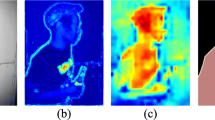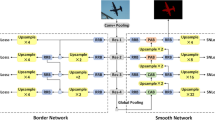Abstract
Semantic segmentation with attention module has made great progress in many computer vision tasks. However, attention modules ignore some boundary information. To explore a more comprehensive map of context features, we propose a pooling position attention network (PPNet) for semantic segmentation. Based on the Encoder-Decoder structure, we import attention modules into the encoder to enhance the correlation between deep information. Pooling cross attention module (PCAM) aims to weight deep semantic information and expands the feature recognition area, and pooling position attention module (PPAM) calculates the weighted features to generate features with strong semantic information. Finally, the enhanced deep features and shallow features are fused by decoder to enhance the dependency between pixels and to achieve better semantic segmentation. Experiments show that of our proposed PPNet is superior to other state-of-the-art models in the performance of segmentation accuracy on datasets PACSCAL VOC 2012 and Cityscapes.





Similar content being viewed by others
Data Availability Statement
The data underlying this article will be shared on reasonable request to the corresponding author.
References
Otsu NA (1979) Threshold selection method from gray-level histograms. In: IEEE Trans Syst Man Cybern 9(1):62–66
Bezdek JC, Ehrlich R, Full W (1984) FCM: The fuzzy c-means clustering algorithm. Comput Geosci 10(2–3):191–203
Ng HP, Ong SH, Foong KWC et al (2006) Medical image segmentation using k-means clustering and improved watershed algorithm. In: 2006 IEEE southwest symposium on image analysis and interpretation. IEEE 2006: 61–65
Long J, Shelhamer E, Darrell T (2015) Fully convolutional networks for semantic segmentation. In: Proceedings of the IEEE conference on computer vision and pattern recognition. pp 3431–3440
Simonyan K, Zisserman A (2014) Very deep convolutional networks for large-scale image recognition. arXiv:1409.1556
Zhao H, Shi J, Qi X et al (2017) Pyramid scene parsing network. In: Proceedings of the IEEE conference on computer vision and pattern recognition. pp 2881–2890
Fu J, Liu J, Tian H, et al (2019) Dual attention network for scene segmentation.In: Proceedings of the IEEE/CVF Conference on Computer Vision and Pattern Recognition. 2019: 3146–3154
Wang X, Girshick R, Gupta A et al (2018) Non-local neural networks. In: Proceedings of the IEEE conference on computer vision and pattern recognition. pp 7794–7803
Huang Z, Wang X, Huang L, et al (2019) Ccnet: Criss-cross attention for semantic segmentation.In: Proceedings of the IEEE/CVF International Conference on Computer Vision. 2019: 603–612
Mostajabi M, Yadollahpour P, Shakhnarovich G (2015) Feedforward semantic segmentation with zoom-out features. In: Proceedings of the IEEE conference on computer vision and pattern recognition. pp 3376–3385
Ghiasi G, Fowlkes CC (2016) Laplacian pyramid reconstruction and refinement for semantic segmentation. In: European conference on computer vision. Springer, Cham, pp 519–534
Kreso I, Causevic D, Krapac J et al (2016) Convolutional scale invariance for semantic segmentation. In: German Conference on Pattern Recognition. Springer, Cham, pp 64–75
Liu Z, Li X, Luo P, et al (2015) Semantic image segmentation via deep parsing network. In: Proceedings of the IEEE international conference on computer vision. 2015: 1377–1385
Yu F, Koltun V (2015) Multi-scale context aggregation by dilated convolutions. arXiv:1511.07122
Lin G, Shen C, Van Den Hengel A et al (2016) Efficient piecewise training of deep structured models for semantic segmentation. In: Proceedings of the IEEE conference on computer vision and pattern recognition. pp 3194–3203
Yuan Y, Chen X, Wang J (2020) Object-contextual representations for semantic segmentation. In: European conference on computer vision. Springer, Cham, pp 173–190
Zheng S, Jayasumana S, Romera-Paredes B et al (2015) Conditional random fields as recurrent neural networks. In: Proceedings of the IEEE international conference on computer vision. 2015: 1529–1537
Raviteja Vemulapalli, Oncel Tuzel, Ming-Yu Liu et al (2016) Gaussian conditional random field network for semantic segmentation. In: IEEE Conf. On Computer Vision and Pattern Recognition (CVPR), Las Vegas, USA, Jun. 26-Jul.1, pp 3224–3233
Li X, Meng L, Tan Y et al (2021) Deep semantic segmentation-based multiple description coding. Multimedia Tools Appl 80(7):10323–10337
Noh H, Hong S, Han B (2015) Learning deconvolution network for semantic segmentation. In: Proceedings of the IEEE international conference on computer vision. pp 1520–1528
Gao S, Cheng M M, Zhao K et al (2019) Res2net: A new multi-scale backbone architecture. IEEE Trans Pattern Anal Mach Intell
Chen LC, Papandreou G, Kokkinos I et al (2014) Semantic image segmentation with deep convolutional nets and fully connected crfs. arXiv:1412.7062
Chen LC, Papandreou G, Kokkinos I et al (2017) Deeplab: Semantic image segmentation with deep convolutional nets, atrous convolution, and fully connected crfs. IEEE Trans Pattern Anal Mach Intell 40(4):834–848
Chen LC, Papandreou G, Schroff F et al (2017) Rethinking atrous convolution for semantic image segmentation. arXiv:1706.05587
Chen LC, Zhu Y, Papandreou G et al (2018) Encoder-decoder with atrous separable convolution for semantic image segmentation. In: Proceedings of the European conference on computer vision (ECCV). pp 801–818
Bahdanau D, Cho K, Bengio Y (2014) Neural machine translation by jointly learning to align and translate. arXiv: arXiv:1409.0473
Ronneberger O, Fischer P, Brox T (2015) U-net: Convolutional networks for biomedical image segmentation. International conference on medical image computing and computer-assisted intervention. Springer, Cham, pp 234–241
Badrinarayanan V, Kendall A, Cipolla R (2017) Segnet: A deep convolutional encoder-decoder architecture for image segmentation. IEEE Trans Pattern Anal Mach Intell 39(12):2481–2495
Lin G, Milan A, Shen C et al (2017) Refinenet: Multi-path refinement networks for high-resolution semantic segmentation. In: Proceedings of the IEEE conference on computer vision and pattern recognition. pp 1925–1934
Hu J, Shen L, Sun G (2018) Squeeze-and-excitation networks. In: Proceedings of the IEEE conference on computer vision and pattern recognition. pp 7132–7141
Zhao H, Zhang Y, Liu S et al (2018) Psanet: Point-wise spatial attention network for scene parsing. In: Proceedings of the European Conference on Computer Vision (ECCV). pp 267–283
He K, Zhang X, Ren S et al (2016) Deep residual learning for image recognition. In: Proceedings of the IEEE conference on computer vision and pattern recognition. 2016: 770–778
Zhou B, Khosla A, Lapedriza A et al (2016) Learning deep features for discriminative localization. In: Proceedings of the IEEE conference on computer vision and pattern recognition. x: 2921–2929
Everingham M, Van Gool L, Williams CKI et al (2010) The pascal visual object classes (voc) challenge. Int J Comput Vis 88(2):303–338
Cordts M, Omran M, Ramos S et al (2016) The cityscapes dataset for semantic urban scene understanding. In: Proceedings of the IEEE conference on computer vision and pattern recognition. pp 3213–3223
Wu T, Huang J, Gao G et al (2021) Embedded discriminative attention mechanism for weakly supervised semantic segmentation. In: Proceedings of the IEEE/CVF conference on computer vision and pattern recognition. pp 16765–16774
Fan M, Lai S, Huang J et al (2021) Rethinking bisenet for real-time semantic segmentation. In: Proceedings of the IEEE/CVF conference on computer vision and pattern recognition. pp 9716–9725
Acknowledgements
This work was supported in part by Key Program of Hunan Provincial Department of Education ( 22A0127), and by Key Laboratory Fund Project (No.2023ICIP07, No.2023ICIP03), and in part by the Natural Science Foundation of China (No.62003288).
Author information
Authors and Affiliations
Corresponding author
Additional information
Publisher's Note
Springer Nature remains neutral with regard to jurisdictional claims in published maps and institutional affiliations.
Rights and permissions
Springer Nature or its licensor (e.g. a society or other partner) holds exclusive rights to this article under a publishing agreement with the author(s) or other rightsholder(s); author self-archiving of the accepted manuscript version of this article is solely governed by the terms of such publishing agreement and applicable law.
About this article
Cite this article
Xu, H., Wang, W., Wang, S. et al. PPNet : pooling position attention network for semantic segmentation. Multimed Tools Appl 83, 37007–37023 (2024). https://doi.org/10.1007/s11042-023-16230-y
Received:
Revised:
Accepted:
Published:
Issue Date:
DOI: https://doi.org/10.1007/s11042-023-16230-y




